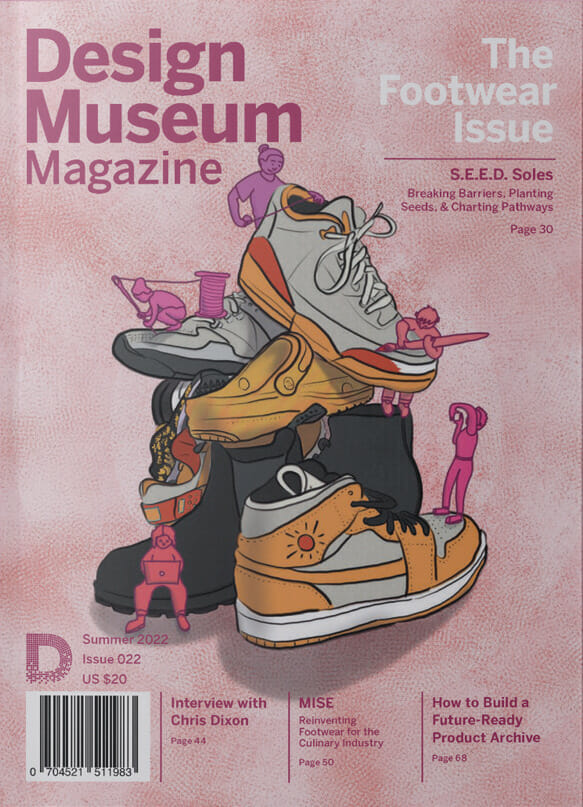Yesterday’s Influencers
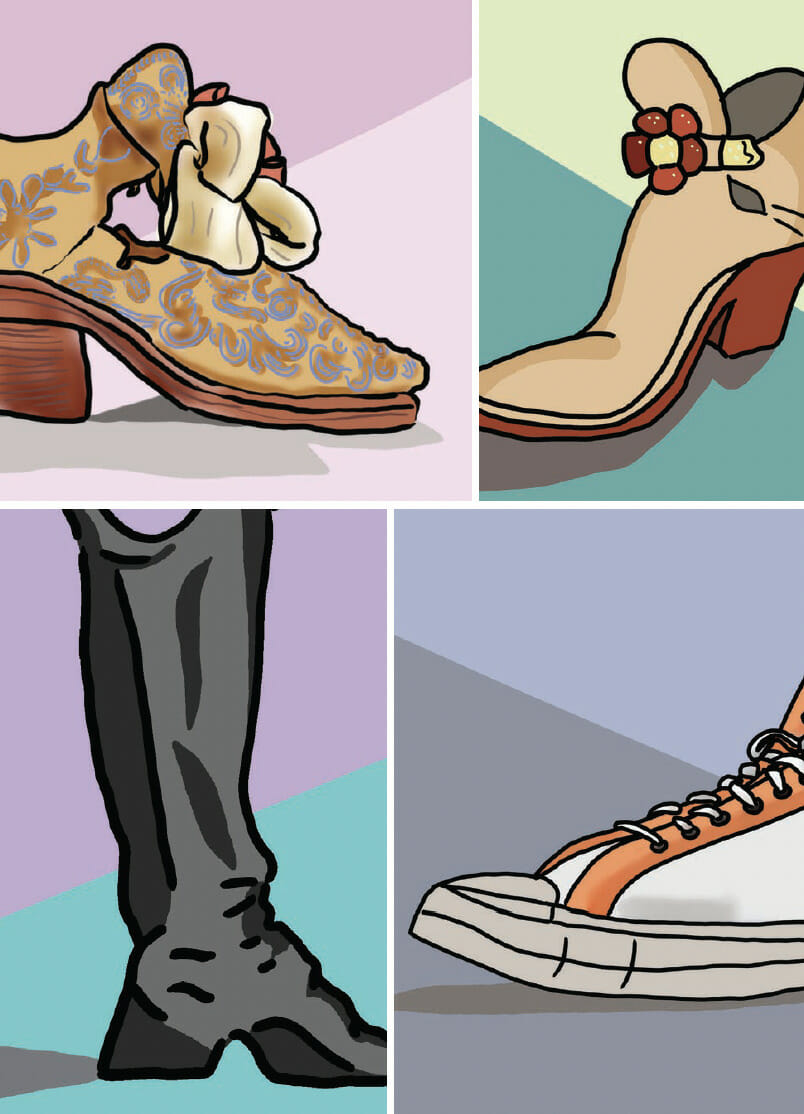
By Stephen Opie, Principal, Opie Design
Illustrations by Penina Gal
Humankind has dedicated its imagination, dexterity, knowledge, and sensitivity to the development of tools that serve their physical needs and psychological desires. Every product and silhouette is in a constant state of evolution, moving from its original form through a series of rises and plateaus. Success arrives when the product meets the needs of a particular time and place. The creation and iteration of footwear has followed this evolutionary arc. From primitive foot coverings to highly technical devices, from natural elements to synthetic formulations, from high to low, from rounded to pointed, and from the simple to the complex. There is no mistaking the significance of shoes in style and culture. Shoes are interpretations of the conditions around us including the politics, religions, economics, and practicalities that shape our lives, but footwear fashion also produces economic, lifestyle, and political change.
The common denominator across these disparate starting points is the person behind the shoe. From early hunter-gatherers to the dandies of the 18th century, every time a pair of shoes were created, purchased, repaired or built, a person was behind the choice to wear that shoe. Whether out of necessity, pride, financial want, or a desire to create social change, these key people developed the shoes that have become our footwear lexicon.
This is a history of these human bellwethers for our footwear decisions. It’s a history of creators, peddlers, salespeople and craftspeople. It’s a history of mover & shakers, designers, and icons. It’s a history of yesterday’s influencers. In respect to all of our past influencers, the following list is cut short. There are many influential candidates who could be included. These chosen individuals present a variety of achievements over a broad period of time.
Otzi the Iceman – The First Trail Shoe
How can the frozen remains of a man from over 5,000 years ago influence today’s footwear world?
The prehistoric mountaineer known as the Otzi Iceman was discovered at a height of more than 10,000 feet in the Otztal Alps near the border between Austria and Italy in 1991. The frozen body was remarkably well-preserved and still clad in primitive clothing, including an animal hide coat, a grass cape, and one shoe. His right shoe was made of various animal skins: bearskin soles, deerskin insteps, and chamois, cow, calf, linden bark uppers. The uppers were worn with fur on the outside and laced up. Dried tree bark was used to weave laces and the shoe was stuffed with hay to keep his feet warm. All of this material was woven between an interlacing twig and thin bark substructure. Although these are the oldest “shoes” ever found, a pair of 10,000-year-old slippers was discovered in Oregon as well as various ancient moccasins found in the Southwest United States.
Otzi’s shoe—likely created to enhance mobility in a tough outdoor world—could be called the first identified trail shoe. Experts reproducing the Otzi shoe found it to be remarkably functional.
Indeed, the Otzi shoe’s semi-rigid outer structure has been mimicked in new advanced footwear technologies, including shoes with an exoskeleton framework and a multi-layered outer shell for protection, durability, and insolation. Dating back 5,300 years, Otzi happened to pass away in the right place at the right time. In doing so, he provides us with an unexpected example of how ancient shoe construction philosophies are still present in today’s modern footwear world. His hand-made artifacts revealed a glimpse into the deep history of truly function-driven footwear— the primary goal still maintained by most footwear companies.
Empress Dowager Cixi – Footbound to Foot-free
How can one woman influence a long-held cultural custom that has debilitated generations of Asian women and become a magnified social problem for her country’s global positioning?
Legend has it that lotus or lily foot slippers first appeared in China in the 11th century when Empress Taki was born with deformed feet. To save her future embarrassment, her father announced that only women with very small feet could be truly feminine and desirable. As a result, women began to bind their feet—a mark of status, beauty, gentility, and sexual attractiveness. Foot binding eventually spread to lower social classes by the Qing dynasty (1636–1912). In 1664, the Manchu Kangxi Emperor attempted to ban the practice, but failed. In some areas, footbinding raised marriage prospects, and by the 19th century, 40–50% of all Chinese women may have had bound feet, rising to almost 100% in upper-class Han Chinese women.
That is until Empress Dowager Cixi (1835–1908) entered the debate. Rising from footbound sexual servitude, she came very close to ending over two millennia of a practice that caused significant physical pain to many women.
She was a fearless leader, the longest ruling woman in Chinese history, and a early feminist leader. When Cixi issued an imperial decree banning the practice of foot binding among women in 1902, she was the first leader to attempt to eliminate the practice.
However, despite her command, footbinding persisted in secret. Unbound feet proved to be politically dangerous. When armies supporting the traditional regimes marched into a village, women with unbound feet were viewed as Communist sympathizers, while women with bound feet were permitted to go free. Today, thanks in large part to the political influence of Empress Cixi, the inhumane practice of footbinding is a relic of footwear history and is no longer practiced.
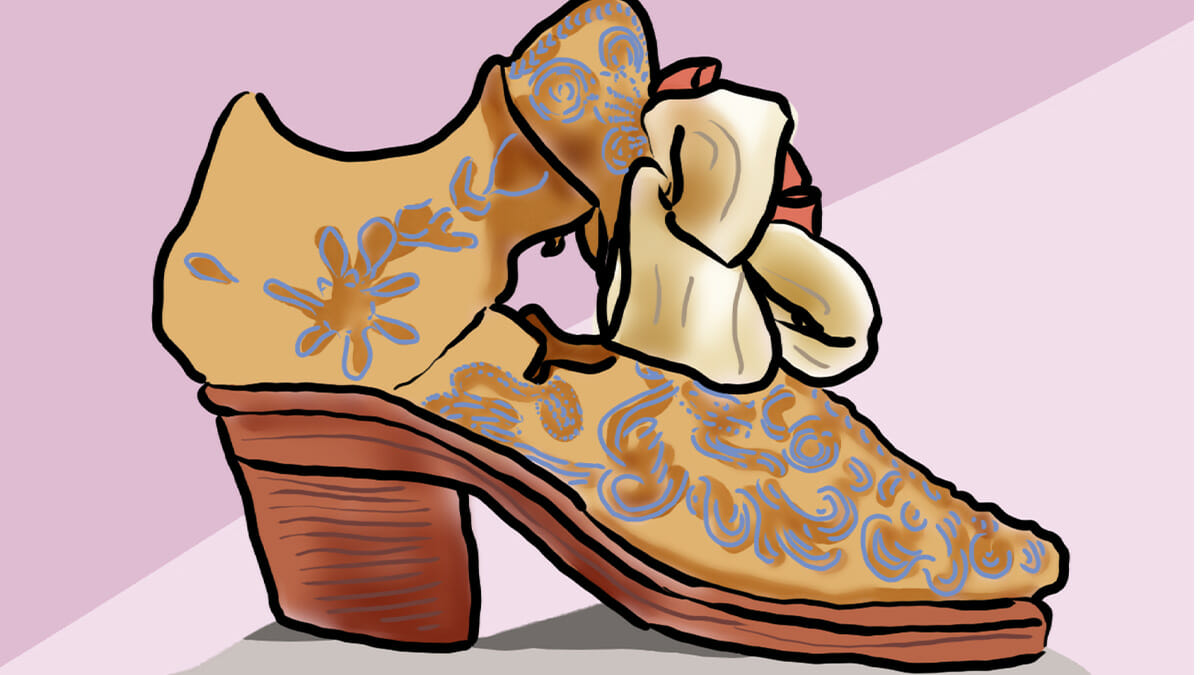
Catherine de Medici – Where Vanity was Born
How can solving for a physical shortcoming transform a personal anxiety into a continent-wide cultural influence?
In the 16th century, the Medici family was one of the most powerful political entities in the world. The Medici were the supreme rulers of Florence and later of Tuscany. They patronized the arts, produced three popes, and arranged enough royal marriages throughout Europe to ensure their lasting influence. These influence-building marriages included the 1533 betrothal of the then 14-year old Catherine de Medici to the Duke of Orleans, who was to become the next King of France, Henry II. Catherine would be expected to participate in the splendid but notoriously judgmental French Court. Catherine worried that her short stature would create a negative first impression. In desperation, she sought the aid of an ingenious Florentine artisan. He produced a creation that would cast a spell over the entire French nation by replacing the clunky wooden soles from Catherine’s shoes with a slender padded four-inch heel.
Her uplifting shoes were an adaptation of chopines, elevated wooden shoes with both heel and toe raised not unlike modern platform shoes. But unlike chopines, the heel was higher than the toe and the “platform” was made to bend in the middle with the foot. High-heeled shoes quickly caught on with the fashion-conscious men and women of the French court, and spread to pockets of nobility in other countries. The term “well-heeled” became synonymous with opulent wealth. For Catherine, her tailor had concocted a device which endowed her with indefinable allure in her walk and gave her the physical stature she could not have otherwise possessed. As necessity is the mother of invention, Catherine de Medici’s influential legacy lives on as the mother of the modern high-heeled shoe.
Louis the 14th – Monitoring the Aristocracy
How can a simple color choice provoke political divisiveness, create social anxiety, and lead to a new representation of power and wealth?
Known as the Sun King, Louis XIV established furniture, footwear, clothing, and jewelry industriesleading France to become the world’s leader in taste and technology. The fashions in which he adorned himself were colorful, voluminous, and ornamental. Fittingly, the Sun King’s outfits often emphasized the color red, including on the soles of his high heeled shoes. French history expert Joan DeJean says red was “always a color associated with palaces, with Versailles.”
Under Louis’s rule, the higher and redder the heel, the more powerful the wearer. When Louis first started wearing red heeled footwear, he would bestow that honor to certain “in-favor” members of his court and even members of his family. Likewise, if Louis did not favor an individual’s politics, actions or beliefs, that individual would be banned from wearing the royal red on their footwear.
In 1660, French shoemaker Nicholas Lestage became shoemaker to Louis XIV, and the heels of Louis’s shoes, some now decorated with miniature battle scenes, were now as tall as five inches. In many ways, Louis’s explicit association of a unique footwear design with political power made him the first footwear celebrity trendsetter. This influence has persisted. His infatuation led to a heel profile forever referred to as the “Louis Heel,” and a red sole remains synonymous with luxury and exclusivity.
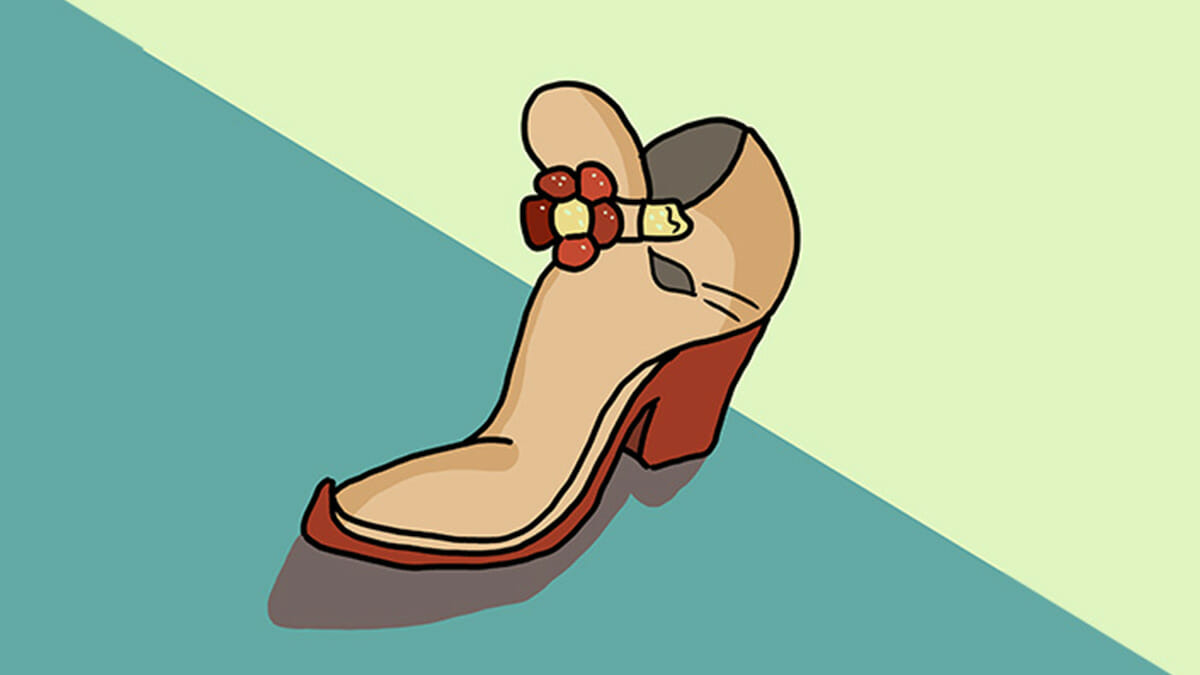
Brummel – Fashion Dandy
How can a British common man, before the age of mass communication create a fresh new style, reinvent a persona, and uplift social status?
George Bryan Brummell, better known as Beau Brummell, became an unlikely arbiter of fashion in 18th century Regency England. Born into a working class family, Beau led the trend for men to wear understated beautifully cut clothes and elaborately knotted neckwear. He established the modern man’s suit with tie as a fashion necessity. His style of dress came to be known as dandyism.
Brummell’s dandyism encouraged English gentlemen to focus on fit, quality, and immaculate cleanliness in their wardrobes. Brummell’s influence also extended to two key footwear innovations, his new Hessian Boot and the Pantaloon Foot Loop. The Hessian boot reached to the knee with a heart shaped topline and had a decorative tassel at the top of each shaft. Initially used as standard issue footwear for the military officers, the Hessian would become widely worn by civilians as well. The boots had a low heel and a semi-pointed toe that made them practical for stirrups. The Hessian boot would evolve into the Wellington boot followed by the rubber work boots known as “wellies.”
With the Hessian boot came a pantaloon, replacing knee breeches. The problem with pantaloons was the wrinkles they formed. To fix this, Brummell invented the foot loop—a distinctive fashionable footnote to the ever-present top hat. Brummel assembled details, materials, and constructions from various cultures, then recreated them into works of his own. He was more than a leader in creating a new men’s style— he demonstrated that male fashion could be an objective of its own, that obsessive dressing could increase one’s class status, and that an immaculate outfit contained fashionable and pristine shoes.
Matzeliger – The Inventor that Changed the Industry
How can a young immigrant overcome a racially divided economic climate to create a game-changing machine?
Jan Ernst Matzeliger was born in Surinam (Dutch Guiana), South America, in 1852. At the age of ten, Jan worked in the machine shops where his talents were nurtured. Hearing about the rapid growth of the shoe industry in Massachusetts, Matzeliger moved to Lynn in 1877 in search of a better job. In the early New England footwear industry, virtually all shoes were assembled by hand stretching leather or textile around a hard rigid form called a last. This construction technique required great skill and it was assumed that such intricate work could only be done by a craftsman. As a result, these hand-lasters held great power and often demanded pay increases resulting in long periods of work stoppages and unemployment for fellow workers.
Matzeliger tried to solve this workplace stranglehold by creating an automated method for lasting footwear. After many years, he came up with a successful prototype. Matzeliger’s machine was able to produce up to 700 pairs a day, a 14-fold increase from an expert hand-laster’s 50. By 1889, there was an overwhelming demand for the machine. Matzeliger formed The Consolidated Lasting Machine Company, which sold lasting machines. In a short period, Matzeliger’s lasting machine revolutionized the American shoe industry and quickly traveled around the world. His invention is still in-use today in most modern footwear factories around the world.
Salvatore Ferragamo – Designer for the Stars
How can an inspired youth develop his skill set to such a high level that his craft becomes a world-wide symbol of glamor, prestige and haute couture?
Salvatore Ferragamo was born in Naples, Italy, in 1898. His parents were poor farmers and could not buy shoes, so Ferragamo, at age 9, borrowed materials and made them himself. At 14, after studying shoemaking in Naples, he opened a shop for hand sewn shoes for women. At age 16, he traveled to California and opened a shoemaking shop in Santa Barbara.
From 1914 to 1923, Farragamo created footwear for the American Film Company. He then relocated to Hollywood and became the “shoemaker of dreams.” For more than 30 years he shod the stars, from Lillian Gish in the first silent films, to Marilyn Monroe in The Seven Year Itch. Worried that his shoes were aesthetically pleasing but anatomically hurtful, Farragamo studied anatomy. After much experimentation, he used this knowledge to perfect a steel instep arch support, making his shoes significantly more comfortable.
Ever the inventor, Farragamo began to experiment with new materials such as needlepoint, lace, hemp, cellophane, raffia, cork, and even fish skin. With a shortage of materials due to WWII, Ferragamo adapted wood and cork into platform soles and inserted cellophane in place of straps. Inspired by the Italian Renaissance, Ferragamo resurrected the chopine, thus inventing our modern wedge heel. The inventor of several trends, like the famous ‘Vera pumps’ and ‘Cage Heels,’ which became icons in their own right, his designs continueto be seen on Hollywood’s biggest stars.
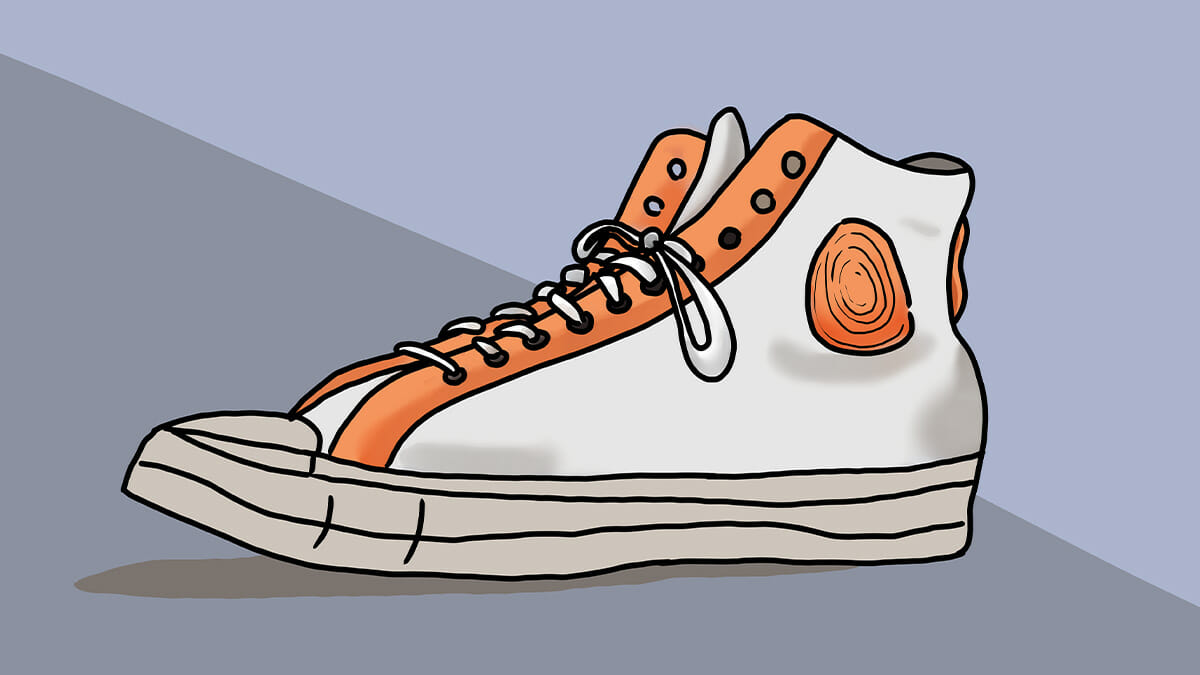
Chuck Taylor
How can one single player through savvy marketing insights and business acumen relabel a product and revolutionize an industry?
In 1921, the Converse Rubber Shoe Company signed the endorsement deal that would significantly change sports marketing and the industry. Professional baller turned salesman Chuck Taylor became Converse’s first player-endorser and became the name behind basketball’s first technical product, the “Chuck Taylor.” But this endorsed athlete agreement turned into something far more meaningful to the footwear industry: the first “signature sneaker” of all-time. Chuck immediately became involved in the design process, helping develop the canvas and vulcanized rubber product beyond the original 1917 creation. His input led to features such as increased ankle support and re-engineering of the rubber compound to increase traction and durability. Taylor, through his savvy understanding of the sporting arena used his influence to promote himself as the sports world’s first professional ambassador thus linking the world of athlete-to-product and paving the road for the future Chamberlain, Bird, Jordan, LeBron and Durant.
These past footwear influencers are remembered for their impact on our collective lives. Their creations improved our mobility. Their sensitivities led to new styles. And their skills, fortitude, and passion created jobs, formed companies, and improved economies. As the footwear world looks towards a new generation, there are numerous uncertainties. We don’t know what technology will upend longstanding production processes. We don’t know what cultural mores will drive new trends. As sport and work develop in new directions, we aren’t sure what needs new shoes will be required to fulfill. And we don’t know what unlikely fashion icons will arise, or how political machinations will drive local customs, or how a changing planet will change what we put on our feet.
But out of all this uncertainty, we can rely on one thing: there will always be a human mind behind the shoe. As we evolve, our shoes evolve with us. And as we look towards the past, we can know that the future of footwear will be reflective of the people behind the shoes.
